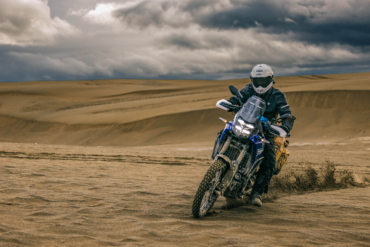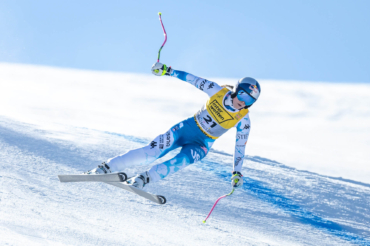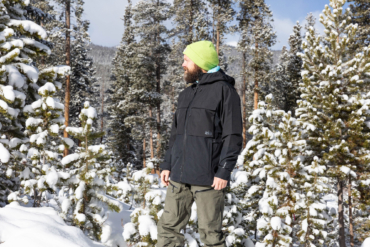Europe’s top-selling snowmobile manufacturer has hopped the Atlantic. Now, U.S. and Canadian trail and backcountry riders can steer these sturdy, high-performance snow machines from a heritage Finnish brand.
More than 1.7 million snowmobiles are registered in Canada and the U.S., according to the International Snowmobile Manufacturers Association. And for 53 years, four major brands have delivered the region’s snowmobiles: Arctic Cat, Polaris, Yamaha, and Ski-Doo.
So last month’s debut of Lynx in North America caused a storm of excitement among riders.

Lynx Snowmobiles: An Option for Variable, Speedy Riding Conditions
Lynx snowmobiles are designed to withstand the harsh Arctic Circle wilderness, where the Finnish brand launched in 1967. Islands of rocks and bare earth mix with wind-scoured, crusty, shallow snow. From Norway to Russia, these machines have long served reindeer herders and racers followed by tourism, recreation, and the military.
Among the fleet, Lynx delivered two models to North American riders: the Rave RE for cross-country and groomed trails and the Boondocker DS for deep snow and backcountry.
In short: Built for active riders, the Rave RE covers rough terrain at high speeds with excellent handling and weight transfer. The Boondocker DS powers through powder and provides stability in variable snow conditions and rugged terrain. Both designs are tailored to experienced high-paced snowmobilers.
Lynx Rave RE Snowmobile Review
I recently took the Rave RE for a 140-mile tour in Island Park, a web of nearly 1,000 miles of groomed trails straddling the Montana-Idaho border, near West Yellowstone. I was attending the Snow Shoot 2021 event, where industry media and leaders gather to test ride the newest snowmobiles.
Our trio of colleagues was led by Idahoan professional rider Tony Jenkins. After summiting Mount Two Top, we descended the ridge and sped to Mesa Falls, a 10-story-high waterfall.
Lynx’s Rave RE (pronounced rah-vay) features the Rotax 850 E-TEC two-stroke engine with 165 horsepower. That’s the same engine found in Ski-Doo mountain sleds (sans turbo option). Lynx was acquired by Ski-Doo’s parent company BRP (Bombardier Recreational Products Inc.) in 1989, so the designs share a bit of crossover.
I found this sled ($17,549) is ergonomically designed for standup, athletic riding on groomed, choppy, and bumpy trails. A wider ski stance, 43.2 inches, provided control and flatter cornering capability even at 50 to 70 mph. The skis dug in and tracked solid through turns on hardpack, especially compared to the mountain sled I usually ride, the Ski-Doo Summit X.
As a smaller person — 5’5”, 130 pounds — I liked the streamlined, firm seat, which made side-to-side maneuvers more efficient.
In standout performance, the Rave RE championed mammoth-size whoops. Under throttle, the skid frame transfers weight back and lifts the front skis, allowing the sled to skim across the top of moguls at high speeds.
At 45 mph, I panned over deep washboard on the one-mile frontage road to Mesa Falls. The PPS3 rear suspension and LFS+ front suspension are uncoupled (the suspension arms work independently), which helps with popping.

Lynx Rave RE Specs
- Engine: Rotax 850 E-TEC
- Maximum RPM: 7,900
- Track length: 137″
- Ski stance: 42.2″
- Starter: Electric and manual
- Riser block: 3.5″
- Fuel tank: 9.7 gallons
- Gauge: 7.2″ wide digital display
- Extra: 12V power outlet
The race shocks are 2-inch-diameter KYB HLCR with a Kashima Coat, an application that reduces friction and increases surface hardness for durability. One potential drawback: The shocks, though adjustable, are stiff. That said, they help prevent bottoming out on flat-out rides if that’s your style.
Lynx Boondocker DS Snowmobile Review
At Snow Shoot, I also spent a day exploring with the Boondocker DS. Our 30-mile group ride was led by noted guide Bret Rasmussen. The Boondocker DS ($15,699) likewise houses the powerful Rotax 850 E-TEC engine. The high-altitude tuned sled has a 165-inch track, and the machine calibrated for sea level has a 154-inch track. I test rode the 165, but the snow wasn’t snorkel-deep.
We traversed variable trails and over whoops to access forested, dynamic terrain with powder stashes in zero degrees Fahrenheit. The conditions were crisp.
What stood out were the PPS2 DS+ rear suspension and LFS front suspension, which also have KYB Kashima Coat shocks. They’re set stiff for aggressive riding, like the Rave RE. The sled stayed cool on the long trail approach: A rear-axle snow guard directs snow spray into the tunnel heat exchanger.
The design replaces a traditional snow flap, like on my Ski-Doo, which gets caught in deep snow.

Boondocker DS Specs
- Engine: Rotax 850 E-TEC
- Maximum RPM: 7,900
- Track length: 154″ or 165″
- Ski stance: 36″
- Starter: Manual with SHOT
- Riser block: 5.5″
- Fuel tank: 9.7 gallons
- Gauge: 4.5″ wide digital display
- Extra: 12V power outlet
Overall, I appreciated the narrow Radien DS platform and seat for easy side-to-side maneuverability. While the Boondocker DS handled variable terrain and dug itself out of pits, it wasn’t plush or easy to edge. In contrast, the 2022 Ski-Doo Summit 850 E-TEC Turbo effortlessly carved and felt nimble.
Overall, the Boondocker DS is a solid steed for technical riders who prefer fast travel off trail and in ranging conditions.
Interested in a machine? Either model can be ordered from a North American Ski-Doo dealer by March 31, 2021.
Check Price at Lynx







